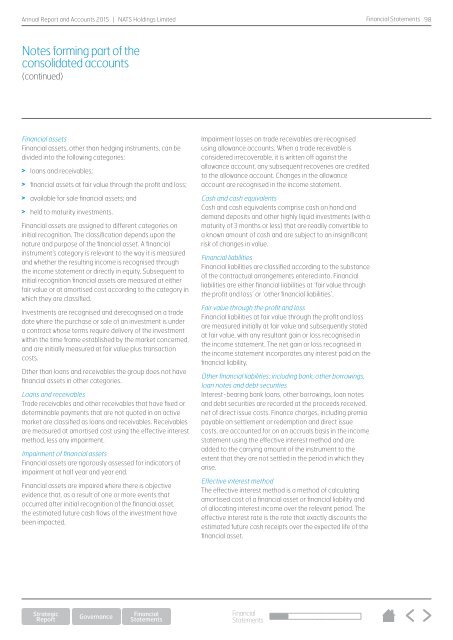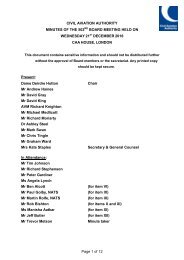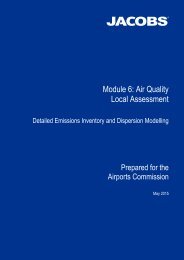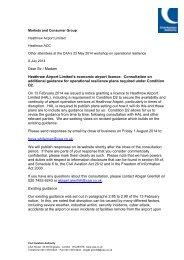NATS-Annual-Report-2015
NATS-Annual-Report-2015
NATS-Annual-Report-2015
Create successful ePaper yourself
Turn your PDF publications into a flip-book with our unique Google optimized e-Paper software.
<strong>Annual</strong> <strong>Report</strong> and Accounts <strong>2015</strong> | <strong>NATS</strong> Holdings Limited<br />
Financial Statements 98<br />
Notes forming part of the<br />
consolidated accounts<br />
(continued)<br />
Financial assets<br />
Financial assets, other than hedging instruments, can be<br />
divided into the following categories:<br />
> loans and receivables;<br />
> financial assets at fair value through the profit and loss;<br />
> available for sale financial assets; and<br />
> held to maturity investments.<br />
Financial assets are assigned to different categories on<br />
initial recognition. The classification depends upon the<br />
nature and purpose of the financial asset. A financial<br />
instrument’s category is relevant to the way it is measured<br />
and whether the resulting income is recognised through<br />
the income statement or directly in equity. Subsequent to<br />
initial recognition financial assets are measured at either<br />
fair value or at amortised cost according to the category in<br />
which they are classified.<br />
Investments are recognised and derecognised on a trade<br />
date where the purchase or sale of an investment is under<br />
a contract whose terms require delivery of the investment<br />
within the time frame established by the market concerned,<br />
and are initially measured at fair value plus transaction<br />
costs.<br />
Other than loans and receivables the group does not have<br />
financial assets in other categories.<br />
Loans and receivables<br />
Trade receivables and other receivables that have fixed or<br />
determinable payments that are not quoted in an active<br />
market are classified as loans and receivables. Receivables<br />
are measured at amortised cost using the effective interest<br />
method, less any impairment.<br />
Impairment of financial assets<br />
Financial assets are rigorously assessed for indicators of<br />
impairment at half year and year end.<br />
Financial assets are impaired where there is objective<br />
evidence that, as a result of one or more events that<br />
occurred after initial recognition of the financial asset,<br />
the estimated future cash flows of the investment have<br />
been impacted.<br />
Impairment losses on trade receivables are recognised<br />
using allowance accounts. When a trade receivable is<br />
considered irrecoverable, it is written off against the<br />
allowance account, any subsequent recoveries are credited<br />
to the allowance account. Changes in the allowance<br />
account are recognised in the income statement.<br />
Cash and cash equivalents<br />
Cash and cash equivalents comprise cash on hand and<br />
demand deposits and other highly liquid investments (with a<br />
maturity of 3 months or less) that are readily convertible to<br />
a known amount of cash and are subject to an insignificant<br />
risk of changes in value.<br />
Financial liabilities<br />
Financial liabilities are classified according to the substance<br />
of the contractual arrangements entered into. Financial<br />
liabilities are either financial liabilities at ‘fair value through<br />
the profit and loss’ or ‘other financial liabilities’.<br />
Fair value through the profit and loss<br />
Financial liabilities at fair value through the profit and loss<br />
are measured initially at fair value and subsequently stated<br />
at fair value, with any resultant gain or loss recognised in<br />
the income statement. The net gain or loss recognised in<br />
the income statement incorporates any interest paid on the<br />
financial liability.<br />
Other financial liabilities: including bank, other borrowings,<br />
loan notes and debt securities<br />
Interest-bearing bank loans, other borrowings, loan notes<br />
and debt securities are recorded at the proceeds received,<br />
net of direct issue costs. Finance charges, including premia<br />
payable on settlement or redemption and direct issue<br />
costs, are accounted for on an accruals basis in the income<br />
statement using the effective interest method and are<br />
added to the carrying amount of the instrument to the<br />
extent that they are not settled in the period in which they<br />
arise.<br />
Effective interest method<br />
The effective interest method is a method of calculating<br />
amortised cost of a financial asset or financial liability and<br />
of allocating interest income over the relevant period. The<br />
effective interest rate is the rate that exactly discounts the<br />
estimated future cash receipts over the expected life of the<br />
financial asset.<br />
Financial<br />
Statements






